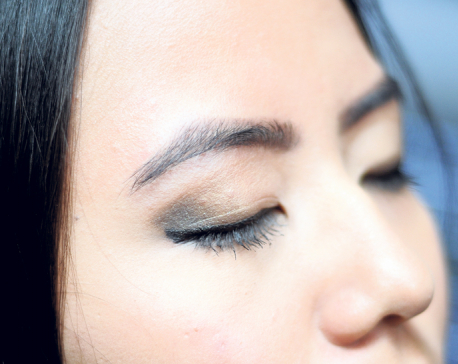
OR

Dr Kishore Pradhan at Tilganga hospital describes interest among Nepali masses to turn to laser surgery for their vision problems as ‘static’. Over the years as he has been heading the procedure in Kathmandu, the number of local patients apparently continues to be less than that of international patients. This is despite the cheap rate of the procedure (at the moment, it is Rs 85,000) that was consciously quoted as such in order to make it more accessible to Nepalis.
There is no denying that many are still wary about laser eye surgery in our country. The Week caught up with Dr Pradhan to get the answers for some of the most common queries and concerns about the procedure.
To begin with, do you find yourself having to convince or reassure people to go for laser surgeries to correct their vision problems?
I don’t try and convince people. I haven’t ever tried coercing anybody into getting laser eye surgeries. I know it is safe. I have done it myself. I know it’s safer than using contact lenses on a daily basis what with its chances for infections. But I don’t insist people to opt for surgery.
The first thing I tell my patients is that I don’t play god here. Laser is also a machine and this is basically a surgery where you are changing the shape of your cornea. So of course, despite its safe rate, there are still many things to be careful about as well.
What are these concerns that you think patients need to be aware of?
Initially, I always let my patients know that everybody is not fit for surgery. I’m very particular about this thing. While the rejection rate at most places tends to be around one to two percent, over at our hospital, it is almost 25%. I’m very fussy on my part especially since majority of the Nepali patients tend to be youngsters.
We carry out multiple scans and tests prior to the surgery to see if the cornea is strong enough. There are other technical factors as well, many that is difficult to explain to people who haven’t studied medicine. But even if there is a slight problem and I see a chance that it might bring on complications later on, I simply say it is better not to get the surgery.
The condition of the cornea and the stability of the eye power are some things we check. If it’s a tricky case, I have even sent scans to London Vision Clinic, where I was trained, for their feedback. If somebody has inflammatory diseases like arthritis, it is best not to operate on them. It’s similar for people with thyroid related diseases as well. I recommend that we treat it first.
What sort of worries do you hear from your patients?
It’s usually about completely losing their eyesight. I ask about the chances of that and I let them know that it is one in a million cases, which means it is extremely rare. And the loss in vision or infections is also often because of other influencing factors during post care which, if taken care of properly, is not an issue at all.
But most of our patients tend to do their research. They come to us asking for SMILE (Small Incision Lenticule Extraction) rather than lasik surgery these days. SMILE is a step ahead of lasik. It is less invasive, the cornea remains stronger, and patients don’t experience much dryness either. This procedure is actually only just taking off in America. It is very advanced. But since I work for the laser company as well and we have several ties with them through our research work and all, we were able to bring the machine here and start the SMILE procedures as well.
What about the side effects of laser eye surgeries? We hear about glares, double vision, or halos, what is that about?
Yes, glare is a common problem but double vision or halos are something else. We haven’t had any cases of the latter ones. They are results of something more than just the normal swelling of the cornea after the surgery like muscles paralysis and such, so in my opinion that’s not a side effect exactly.
Glares, on the other hand, are experienced by everybody to different degrees after the surgery. Some don’t even realize it is there whereas for some it is prominent especially during night time, where the lights appear scattered like a burst of stars. But they do disappear eventually. Depending on our individual healing mechanism, it can disappear faster or slower. The younger you are, the faster it goes away. Also in SMILE procedures, the degree of glare is a lot less.
Even I experience glare during night time but this isn’t something that will bother you during the day.
Isn’t there any remedy for it?
You can always get it diagnosed. After you find the reason behind the glare, you can seek various methods to reduce it. For example, if it is cataract dominant than cataract surgery is an option. Usually though, glares are caused because of swelling of the cornea for which you have anti swelling drops. When the swelling goes down, the glare goes down as well. Plus these days you even have glasses for it which will help you manage them significantly. Sometimes these glares can be experienced for a long time, mostly at night. But, with time, it will go away.
There is also a suspicion that the results of these procedures won’t last long, that you will end up with glasses again?
This doesn’t apply to everybody. This is also where the aspect of training comes to play. When you change the shape of the cornea, it tends to come back again slightly, for a better understanding, let’s say, bounce back a little. Now how much will come back? The doctor must be mindful of that.
If I’m performing an eye surgery of this nature, I should know how much to correct. We have formulas for that. That’s where you tap into the aspects of your training. This is why you can’t just buy a machine and start a clinic. That doesn’t result in effective treatment.
Having said that, it’s important to note that this is also not a onetime treatment. If you feel your vision declining, you can always re-tweak it. For instance, a person who has had a surgery at 20, can go back at 40 and, if necessary, do it again at 65. Baring other health issues, you are never too old to get laser eye surgery.
Lastly, what about post care, is it challenging?
I always ask for optimum care during the first week after surgery. We are really concerned. Kathmandu has a lot of dust and pollution so we teach our patients to clean and care for their eyes post surgery. We also make sure they have sufficient antibiotics.
In the last five years, we have had two cases of pretty bad infections. One was because of negligence on the patient’s part. He was riding his bike just a couple of days after his surgery. But the other was by chance. Either way, we were able to cure them with antibiotics and steroids. They didn’t lose a single line of vision.
You May Like This

Bag it right
Bags are perhaps one of the most underrated investments in the style department. While it is always tempting to purchase... Read More...

Drawing it as it is
I came up with the name Miss Moti because a friend used to call me Moti. I wanted to change... Read More...

Apply it right
The most basic thing you can control while applying makeup to make sure you don’t look like a clown when... Read More...





Just In
- MoHP cautions docs working in govt hospitals not to work in private ones
- Over 400,000 tourists visited Mustang by road last year
- 19 hydropower projects to be showcased at investment summit
- Global oil and gold prices surge as Israel retaliates against Iran
- Sajha Yatayat cancels CEO appointment process for lack of candidates
- Govt padlocks Nepal Scouts’ property illegally occupied by NC lawmaker Deepak Khadka
- FWEAN meets with President Paudel to solicit support for women entrepreneurship
- Koshi provincial assembly passes resolution motion calling for special session by majority votes






_20220508065243.jpg)






Leave A Comment